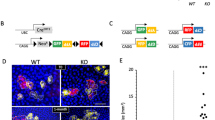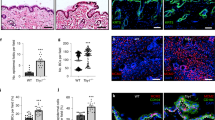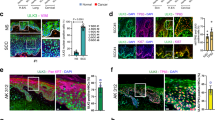Abstract
E-cadherin is a cell adhesion molecule best known for its function in suppressing tumor progression and metastasis. Here we show that E-cadherin promotes nucleotide excision repair through positively regulating the expression of xeroderma pigmentosum complementation group C (XPC) and DNA damage-binding protein 1 (DDB1). Loss of E-cadherin activates the E2F4 and p130/107 transcription repressor complexes to suppress the transcription of both XPC and DDB1 through activating the transforming growth factor-β (TGF-β) pathway. Adding XPC or DDB1, or inhibiting the TGF-β pathway, increases the repair of ultraviolet (UV)-induced DNA damage in E-cadherin-inhibited cells. In the mouse skin and skin tumors, UVB radiation downregulates E-cadherin. In sun-associated premalignant and malignant skin neoplasia, E-cadherin is downregulated in association with reduced XPC and DDB1 levels. These findings demonstrate a crucial role of E-cadherin in efficient DNA repair of UV-induced DNA damage, identify a new link between epithelial adhesion and DNA repair and suggest a mechanistic link of early E-cadherin loss in tumor initiation.
This is a preview of subscription content, access via your institution
Access options
Subscribe to this journal
Receive 50 print issues and online access
$259.00 per year
only $5.18 per issue
Buy this article
- Purchase on Springer Link
- Instant access to full article PDF
Prices may be subject to local taxes which are calculated during checkout







Similar content being viewed by others
References
Sancar A, Lindsey-Boltz LA, Unsal-Kacmaz K, Linn S . Molecular mechanisms of mammalian DNA repair and the DNA damage checkpoints. Annu Rev Biochem 2004; 73: 39–85.
Niggli HJ, Rothlisberger R . Cyclobutane-type pyrimidine photodimer formation and induction of ornithine decarboxylase in human skin fibroblasts after UV irradiation. J Invest Dermatol 1988; 91: 579–584.
Vink AA, Berg RJ, de Gruijl FR, Roza L, Baan RA . Induction, repair and accumulation of thymine dimers in the skin of UV-B-irradiated hairless mice. Carcinogenesis 1991; 12: 861–864.
Cleaver JE . Cancer in xeroderma pigmentosum and related disorders of DNA repair. Nat Rev Cancer 2005; 5: 564–573.
Cleaver JE, Lam ET, Revet I . Disorders of nucleotide excision repair: the genetic and molecular basis of heterogeneity. Nat Rev Genet 2009; 10: 756–768.
Braithwaite E, Wu X, Wang Z . Repair of DNA lesions induced by polycyclic aromatic hydrocarbons in human cell-free extracts: involvement of two excision repair mechanisms in vitro. Carcinogenesis 1998; 19: 1239–1246.
Kad NM, Wang H, Kennedy GG, Warshaw DM, Van Houten B . Collaborative dynamic DNA scanning by nucleotide excision repair proteins investigated by single- molecule imaging of quantum-dot-labeled proteins. Mol Cell 2010; 37: 702–713.
Hoeijmakers JH . Genome maintenance mechanisms for preventing cancer. Nature 2001; 411: 366–374.
DiGiovanna JJ, Kraemer KH . Shining a light on xeroderma pigmentosum. J Invest Dermatol 2012; 132: 785–796.
Sugasawa K . Xeroderma pigmentosum genes: functions inside and outside DNA repair. Carcinogenesis 2008; 29: 455–465.
Bradford PT, Goldstein AM, Tamura D, Khan SG, Ueda T, Boyle J et al. Cancer and neurologic degeneration in xeroderma pigmentosum: long term follow-up characterises the role of DNA repair. J Med Genet 2011; 48: 168–176.
Volker M, Mone MJ, Karmakar P, van Hoffen A, Schul W, Vermeulen W et al. Sequential assembly of the nucleotide excision repair factors in vivo. Mol Cell 2001; 8: 213–224.
Sugasawa K, Ng JM, Masutani C, Iwai S, van der Spek PJ, Eker AP et al. Xeroderma pigmentosum group C protein complex is the initiator of global genome nucleotide excision repair. Mol Cell 1998; 2: 223–232.
Riedl T, Hanaoka F, Egly JM . The comings and goings of nucleotide excision repair factors on damaged DNA. EMBO J 2003; 22: 5293–5303.
Sugasawa K, Okuda Y, Saijo M, Nishi R, Matsuda N, Chu G et al. UV-induced ubiquitylation of XPC protein mediated by UV-DDB-ubiquitin ligase complex. Cell 2005; 121: 387–400.
Sugasawa K . UV-DDB: a molecular machine linking DNA repair with ubiquitination. DNA Repair (Amst) 2009; 8: 969–972.
Huang TT, D'Andrea AD . Regulation of DNA repair by ubiquitylation. Nat Rev Mol Cell Biol 2006; 7: 323–334.
Kim I, He YY . Ultraviolet radiation-induced non-melanoma skin cancer: regulation of DNA damage repair and inflammation. Genes Dis 2014; 1: 188–198.
Shah P, He YY . Molecular regulation of UV-induced DNA repair. Photochem Photobiol 2015; 91: 254–264.
Perez-Moreno M, Jamora C, Fuchs E . Sticky business: orchestrating cellular signals at adherens junctions. Cell 2003; 112: 535–548.
van Roy F, Berx G . The cell-cell adhesion molecule E-cadherin. Cell Mol Life Sci 2008; 65: 3756–3788.
Hulsken J, Birchmeier W, Behrens J . E-cadherin and APC compete for the interaction with beta-catenin and the cytoskeleton. J Cell Biol 1994; 127: 2061–2069.
Hanahan D, Weinberg RA . Hallmarks of cancer: the next generation. Cell 2011; 144: 646–674.
Yang J, Weinberg RA . Epithelial-mesenchymal transition: at the crossroads of development and tumor metastasis. Dev Cell 2008; 14: 818–829.
Margulis A, Zhang W, Alt-Holland A, Crawford HC, Fusenig NE, Garlick JA . E-cadherin suppression accelerates squamous cell carcinoma progression in three-dimensional, human tissue constructs. Cancer Res 2005; 65: 1783–1791.
Gu C, Zhang Q, Yang Z, Wang Y, Zou Y, Wang Y . Recognition and incision of oxidative intrastrand cross-link lesions by UvrABC nuclease. Biochemistry 2006; 45: 10739–10746.
Navarro P, Gomez M, Pizarro A, Gamallo C, Quintanilla M, Cano A . A role for the E-cadherin cell-cell adhesion molecule during tumor progression of mouse epidermal carcinogenesis. J Cell Biol 1991; 115: 517–533.
Brouxhon S, Kyrkanides S, O'Banion MK, Johnson R, Pearce DA, Centola GM et al. Sequential down-regulation of E-cadherin with squamous cell carcinoma progression: loss of E-cadherin via a prostaglandin E2-EP2 dependent posttranslational mechanism. Cancer Res 2007; 67: 7654–7664.
Qiang L, Zhao BZ, Ming M, Wang N, He TC, Hwang S et al. Regulation of cell proliferation and migration by p62 through stabilization of Twist1. Proc Natl Acad Sci USA 2014; 111: 9241–9246.
Nakagawa H, Hikiba Y, Hirata Y, Font-Burgada J, Sakamoto K, Hayakawa Y et al. Loss of liver E-cadherin induces sclerosing cholangitis and promotes carcinogenesis. Proc Natl Acad Sci USA 2014; 111: 1090–1095.
Derksen PW, Liu X, Saridin F, van der Gulden H, Zevenhoven J, Evers B et al. Somatic inactivation of E-cadherin and p53 in mice leads to metastatic lobular mammary carcinoma through induction of anoikis resistance and angiogenesis. Cancer Cell 2006; 10: 437–449.
Jamal S, Schneider RJ . UV-induction of keratinocyte endothelin-1 downregulates E-cadherin in melanocytes and melanoma cells. J Clin Invest 2002; 110: 443–452.
Li J, Wang QE, Zhu Q, El-Mahdy MA, Wani G, Praetorius-Ibba M et al. DNA damage binding protein component DDB1 participates in nucleotide excision repair through DDB2 DNA-binding and cullin 4A ubiquitin ligase activity. Cancer Res 2006; 66: 8590–8597.
Oh KS, Imoto K, Emmert S, Tamura D, DiGiovanna JJ, Kraemer KH . Nucleotide excision repair proteins rapidly accumulate but fail to persist in human XP-E (DDB2 mutant) cells. Photochem Photobiol 2011; 87: 729–733.
Orsulic S, Huber O, Aberle H, Arnold S, Kemler R . E-cadherin binding prevents beta-catenin nuclear localization and beta-catenin/LEF-1-mediated transactivation. J Cell Sci 1999; 112: 1237–1245.
Massague J . TGFbeta signalling in context. Nat Rev Mol Cell Biol 2012; 13: 616–630.
Ikushima H, Miyazono K . TGFbeta signalling: a complex web in cancer progression. Nat Rev Cancer 2010; 10: 415–424.
Fleisch MC, Maxwell CA, Barcellos-Hoff MH . The pleiotropic roles of transforming growth factor beta in homeostasis and carcinogenesis of endocrine organs. Endocr Relat Cancer 2006; 13: 379–400.
Kao YC, Wu LW, Shi CS, Chu CH, Huang CW, Kuo CP et al. Downregulation of thrombomodulin, a novel target of Snail, induces tumorigenesis through epithelial-mesenchymal transition. Mol Cell Biol 2010; 30: 4767–4785.
Vogelmann R, Nguyen-Tat MD, Giehl K, Adler G, Wedlich D, Menke A . TGFbeta-induced downregulation of E-cadherin-based cell-cell adhesion depends on PI3-kinase and PTEN. J Cell Sci 2005; 118: 4901–4912.
Chen CR, Kang Y, Siegel PM, Massague J . E2F4/5 and p107 as Smad cofactors linking the TGFbeta receptor to c-myc repression. Cell 2002; 110: 19–32.
Cam H, Balciunaite E, Blais A, Spektor A, Scarpulla RC, Young R et al. A common set of gene regulatory networks links metabolism and growth inhibition. Mol Cell 2004; 16: 399–411.
Dominguez-Brauer C, Chen YJ, Brauer PM, Pimkina J, Raychaudhuri P . ARF stimulates XPC to trigger nucleotide excision repair by regulating the repressor complex of E2F4. EMBO Rep 2009; 10: 1036–1042.
Ming M, Shea CR, Guo X, Li X, Soltani K, Han W et al. Regulation of global genome nucleotide excision repair by SIRT1 through xeroderma pigmentosum C. Proc Natl Acad Sci USA 2010; 107: 22623–22628.
Nichols AF, Itoh T, Zolezzi F, Hutsell S, Linn S . Basal transcriptional regulation of human damage-specific DNA-binding protein genes DDB1 and DDB2 by Sp1, E2F, N-myc and NF1 elements. Nucleic Acids Res 2003; 31: 562–569.
Frederick JP, Liberati NT, Waddell DS, Shi Y, Wang XF . Transforming growth factor beta-mediated transcriptional repression of c-myc is dependent on direct binding of Smad3 to a novel repressive Smad binding element. Mol Cell Biol 2004; 24: 2546–2559.
Cui T, Srivastava AK, Han C, Yang L, Zhao R, Zou N et al. XPC inhibits NSCLC cell proliferation and migration by enhancing E-Cadherin expression. Oncotarget 2015; 6: 10060–10072.
Fei J, Kaczmarek N, Luch A, Glas A, Carell T, Naegeli H . Regulation of nucleotide excision repair by UV-DDB: prioritization of damage recognition to internucleosomal DNA. PLoS Biol 2011; 9: e1001183.
Cho IJ, Kim YW, Han CY, Kim EH, Anderson RA, Lee YS et al. E-cadherin antagonizes transforming growth factor beta1 gene induction in hepatic stellate cells by inhibiting RhoA-dependent Smad3 phosphorylation. Hepatology 2010; 52: 2053–2064.
Glick AB . The role of TGFbeta signaling in squamous cell cancer: lessons from mouse models. J Skin Cancer 2012; 2012: 249063.
Hoot KE, Lighthall J, Han G, Lu SL, Li A, Ju W et al. Keratinocyte-specific Smad2 ablation results in increased epithelial-mesenchymal transition during skin cancer formation and progression. J Clin Invest 2008; 118: 2722–2732.
Mitra D, Fernandez P, Bian L, Song N, Li F, Han G et al. Smad4 loss in mouse keratinocytes leads to increased susceptibility to UV carcinogenesis with reduced Ercc1-mediated DNA repair. J Invest Dermatol 2013; 133: 2609–2616.
Li AG, Lu SL, Zhang MX, Deng C, Wang XJ . Smad3 knockout mice exhibit a resistance to skin chemical carcinogenesis. Cancer Res 2004; 64: 7836–7845.
Jans J, Schul W, Sert YG, Rijksen Y, Rebel H, Eker AP et al. Powerful skin cancer protection by a CPD-photolyase transgene. Curr Biol 2005; 15: 105–115.
Yi JY, Kim MR, Lee J, An YS, Jin YB, Park IC et al. TGF-beta1 protects cells from gamma-IR by enhancing the activity of the NHEJ repair pathway. Mol Cancer Res 2014; 13: 319–329.
Dubrovska A, Kanamoto T, Lomnytska M, Heldin CH, Volodko N, Souchelnytskyi S . TGFbeta1/Smad3 counteracts BRCA1-dependent repair of DNA damage. Oncogene 2005; 24: 2289–2297.
Perez-Lorenzo R, Markell LM, Hogan KA, Yuspa SH, Glick AB . Transforming growth factor beta1 enhances tumor promotion in mouse skin carcinogenesis. Carcinogenesis 2010; 31: 1116–1123.
Wang H, Kochevar IE . Involvement of UVB-induced reactive oxygen species in TGF-beta biosynthesis and activation in keratinocytes. Free Radic Biol Med 2005; 38: 890–897.
Ravindran A, Mohammed J, Gunderson AJ, Cui X, Glick AB . Tumor-promoting role of TGFbeta1 signaling in ultraviolet B-induced skin carcinogenesis is associated with cutaneous inflammation and lymph node migration of dermal dendritic cells. Carcinogenesis 2014; 35: 959–966.
Katsumi S, Kobayashi N, Imoto K, Nakagawa A, Yamashina Y, Muramatsu T et al. In situ visualization of ultraviolet-light-induced DNA damage repair in locally irradiated human fibroblasts. J Invest Dermatol 2001; 117: 1156–1161.
Kobayashi N, Katsumi S, Imoto K, Nakagawa A, Miyagawa S, Furumura M et al. Quantitation and visualization of ultraviolet-induced DNA damage using specific antibodies: application to pigment cell biology. Pigment Cell Res 2001; 14: 94–102.
Imoto K, Kobayashi N, Katsumi S, Nishiwaki Y, Iwamoto TA, Yamamoto A et al. The total amount of DNA damage determines ultraviolet-radiation-induced cytotoxicity after uniform or localized irradiation of human cells. J Invest Dermatol 2002; 119: 1177–1182.
Boyle J, Ueda T, Oh KS, Imoto K, Tamura D, Jagdeo J et al. Persistence of repair proteins at unrepaired DNA damage distinguishes diseases with ERCC2 (XPD) mutations: cancer-prone xeroderma pigmentosum vs. non-cancer-prone trichothiodystrophy. Hum Mutat 2008; 29: 1194–1208.
Wang QE, Han C, Zhao R, Wani G, Zhu Q, Gong L et al. p38 MAPK- and Akt-mediated p300 phosphorylation regulates its degradation to facilitate nucleotide excision repair. Nucleic Acids Res 2013; 41: 1722–1733.
Acknowledgements
We are grateful to Dr Altaf Wani for his helpful suggestions. We thank Terri Li for immunohistochemistry and Dr Ann Motten for a critical reading of the manuscript. This work was supported by the NIH/NIEHS grants ES016936 and ES024373 (to YYH), the American Cancer Society (ACS) grant RSG-13-078-01 (to YYH), the University of Chicago Cancer Research Center (P30 CA014599), the CTSA (UL1 TR000430) and the University of Chicago Friends of Dermatology Endowment Fund.
Author information
Authors and Affiliations
Corresponding author
Ethics declarations
Competing interests
The authors declare no conflict of interest.
Additional information
Supplementary Information accompanies this paper on the Oncogene website
Rights and permissions
About this article
Cite this article
Qiang, L., Shah, P., Barcellos-Hoff, M. et al. TGF-β signaling links E-cadherin loss to suppression of nucleotide excision repair. Oncogene 35, 3293–3302 (2016). https://doi.org/10.1038/onc.2015.390
Received:
Revised:
Accepted:
Published:
Issue Date:
DOI: https://doi.org/10.1038/onc.2015.390
This article is cited by
-
TGFβ signaling links early life endocrine-disrupting chemicals exposure to suppression of nucleotide excision repair in rat myometrial stem cells
Cellular and Molecular Life Sciences (2023)
-
E2F4 transcription factor is a prognostic biomarker related to immune infiltration of head and neck squamous cell carcinoma
Scientific Reports (2022)
-
Epidermal SIRT1 regulates inflammation, cell migration, and wound healing
Scientific Reports (2017)



